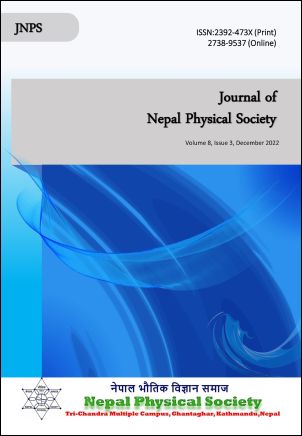Spatial Distribution of Groundwater Level over Lowlands of Morang District of Eastern-Nepal
DOI:
https://doi.org/10.3126/jnphyssoc.v8i3.50724Keywords:
Groundwater, IDW, Spatial Interpolation, Morang, NepalAbstract
A better understanding of spatial distribution of groundwater level is necessary for the development of groundwater development strategies and sustainable use of available resources. The present study evaluates the spatial distribution of groundwater level over the Morang Administrative District of Eastern Nepal and the groundwater accessibility over the area. The study was realized by performing an extensive field survey of groundwater level during the post-monsoon season over 126 sites. The study area of 1224.80 km2 was gridded at 3 km x 3 km horizontal grid resolution and at least one survey was ensured for each grid point. Downscaled spatial distribution of groundwater level was achieved by interpolating the observed data using the Inverse Distance Weighting (IDW) with different weighting parameters available with the geostatistical module of ArcGIS. The performances of the interpolation methods were evaluated based on the cross-validation of results characterized by the statistical parameters RMSE, R2 and MAE and optimal power (α) for weighting function. The IDW (with α=4) appears to perform well for the study area with Coefficient of Determination (R2) and Root Mean Square Error (RMSE) and Mean Absolute Error (MAE) values of 0.336, 4.750 and 2.967, respectively. The spatial distribution of groundwater level over the low-lands of Morang District mapped with the IDW interpolation method, revealed that the ground water level is maximum in south-western part of the district. The depth to groundwater lies between the ranges of 4.5 to 10 meters covering almost 67.47% of the total study area.
Downloads
Downloads
Published
How to Cite
Issue
Section
License
All right reserved. No part of this Journal may be reproduced in any form or by any electronic or mechanical means, including information storage and retrieval system, without permission in writing from the publisher, except by a reviewer who may quote brief passage in a review. The views and interpretation in this journal are those of author(s) and they are not attributable to the NPS.




